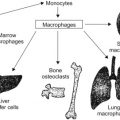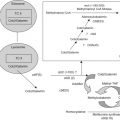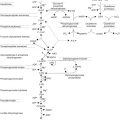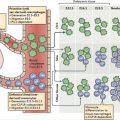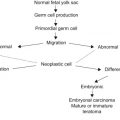Abstract
Soft-tissue sarcomas (STS) are a heterogeneous group of malignant tumors derived from primitive mesenchymal cells. These tumors arise from muscle, connective tissue, supportive tissue, and vascular tissue. As a group, they are locally highly invasive and have a high propensity for local recurrence. They can be divided into two main groups: rhabodomyosarcoma (RMS) and nonrhabdomyosarcoma (NRSTS).
Keywords
Rhabdomyosarcoma (RMS), Nonrhabomyosarcoma Soft Tissue Sarcoma (NRSTS)
Soft-tissue sarcomas (STS) are a heterogeneous group of malignant tumors derived from primitive mesenchymal cells. These tumors arise from muscle, connective tissue, supportive tissue, and vascular tissue. As a group, they are locally highly invasive and have a high propensity for local recurrence. They usually metastasize via the bloodstream and, less commonly, via the lymphatics. The STS can be divided into two groups:
- 1.
Rhabdomyosarcoma (RMS).
- 2.
Nonrhabdomyosarcoma soft-tissue sarcomas (NRSTS).
Incidence and Epidemiology
STS account for 7% of childhood malignancies. RMS accounts for 40% of STS and RMS is the most common pediatric STS, with an incidence of 4–5 per million in children less than 15 years old.
- •
RMS is the third most common solid extracranial tumor, following neuroblastoma and Wilms’ tumor.
- •
RMS accounts for 3% of all malignant neoplasms in children, with approximately 400 new cases diagnosed in the United States each year in children under 19 years of age.
- •
Approximately one-third of cases of RMS are in children less than 5 years of age and 60% of cases are diagnosed in children less than 10 of age.
- •
In RMS there is a slight male predominance with a male:female ratio of 1.4:1; however adolescent patients are disproportionately males.
- •
RMS incidence in African-American females is half that of Caucasian females. The incidence is lower in Asian populations residing in Asia or the West.
NRSTS comprise a diverse group of malignancies. Although each type is rare, together they constitute about 60% of all pediatric STS with an incidence of 6–8 cases per million in children less than 20 years of age. There are approximately 550–600 new NRSTS cases per year in the United States, which represents 4% of all pediatric malignancies. Among the NRSTS the most common subtypes include synovial sarcoma, malignant peripheral nerve sheath tumors (MPNST), dermatofibrosarcoma protuberans (DFSP), malignant fibrous histiocytoma, and fibrosarcoma. Tumors typically found in children under 5 years of age are infantile fibrosarcoma and infantile hemangioperiocytoma. Males are affected slightly more than females and African-Americans are affected slightly more often than Caucasians.
Most cases of STS occur sporadically but up to 30% of cases may have an underlying risk factor, which may include:
- •
Germline mutations of the p53 suppressor gene, as in Li–Fraumeni familial cancer syndrome. There is an association between early-onset breast cancer, sarcomas, brain tumors, and adrenocortical tumors in family members.
- •
Ionizing radiation.
- •
Neurofibromatosis ( NF1 )—patients with NF1 have up to a 15% lifetime risk of developing an MPNST associated with chromosome 17 deletions.
- •
Syndromes such as Beckwith–Weidemann syndrome and Costello syndrome (a genetic disorder characterized by delayed development and mental retardation, unusually flexible joints, hypertrophic cardiomyopathy, short stature, and an increased risk of developing tumors, with the most frequent being RMS).
- •
DICER1 mutations—familial pleuropulmonary blastoma predisposition syndrome increases the risk of developing tumors including embryonal RMS (ERMS).
- •
Maternal and paternal use of marijuana and cocaine and first-trimester prenatal X-ray exposure, possibly as an environmental interaction with a genetic trigger.
Pathologic and Genetic Classification
Immunohistochemistry, molecular diagnostics including reverse-transcriptase polymerase chain reaction and/or fluorescence in situ hybridization may be necessary to differentiate RMS and NRSTS from the other small round blue cell tumors of childhood (i.e., lymphoma, Ewing sarcoma, neuroblastoma). There are various chromosomal translocations that are characteristic of NRSTS which have led to the refinement of the histopathological classification of pediatric STS. Table 26.1 summarizes the clinical and biological features of NRSTS. Table 26.2 lists the histologic subtypes of RMS with reference to their morphology, site of origin, and age distribution.
| Tumor a | Cell origin/cytogenetics/product | Common sites | Common ages | Good prognostic factors b | Outcome | Therapy |
|---|---|---|---|---|---|---|
| Synovial sarcoma | Mesenchymal cells/t(X;18) (p11q11)/ SSX1-SYT (seen in biphasic tumors) SSX2-SYT (seen in monophasic tumors)/translocation present in >90%, mycn overexpression | Extremities (lower twice as common as upper extremity) | Adolescence/young adulthood, accounts for 30% of pediatric NRSTS | Age≤14 years, size <5 cm, calcification, chemosensitive | Stages I and II, 70%; stages III and IV, poor | WLE with/without RT Chemo: ifosfamide/doxorubicin |
| Dermatofibrosarcoma Protuberans (DFDSP) | Dermis/t(17;22)(q21;q13) ring chromosome/ COL1A1-PDGFB | Trunk and proximal limbs, rare head and neck | 20–50 years, rare in childhood | Complete excision, local recurrence 60% with incomplete resection | WLE (3 cm) margin pseudopod-like projections with Mohs micrographic surgery, RT has been used when WLE not possible, Imatinib for unresectable, locally advanced, recurrent or metastatic disease | |
| Malignant fibrous histiocytoma (MFH aka undifferentiated pleomorphic sarcoma) | Unknown/19p+, complex abnormalities | Lower extremity, trunk, head and neck | In children, 10–20 years, 40–60 years Common radiation-induced sarcoma | Extremity site | 5-year survival, 27–53% | WLE Chemo: ifosfamide/doxorubicin |
| Angiomatoid fibrous histiocytoma | Fibroblast/t(2;22) (q34;q12) t(12;16)(q13;p11) t(12;22)(q13;q12)/ EWSR1-CREB1 TLS-ATF1 EWSR1-ATF1 | Extremity, trunk and head and neck (subcutis may infiltrate dermis or muscle) | Young children and young adults | Much less aggressive than MFH | Excellent with surgery alone | WLE |
| Malignant peripheral nerve sheath tumor (MPNST) | Schwann cell or fibroblast/17q, 22q loss or rearrangement, complex abnormalities in high-grade tumors | Extremity, retroperitoneum trunk | Younger in patients with Neurofibromatosis (NF1) Develop in 10% patients with NF1 and 20–60% cases of MPNST occur in association with NF1 . | Size<5 cm, No NF1 | 53% survival without NF, 16% with NF | WLE with/without RT Chemo: neoadjuvant role, ifosfamide/doxorubicin |
| Fibrosarcoma | Fibroblast/t(X;18), t(2;5), t(7;22) | Truncal/Proximal site | Adolescence | 5-year survival 34–60% | WLE with/without RT Chemo: no established role | |
| Infantile fibrosarcoma | Fibroblast/t(12;15) (p13;q25)/ ETV6-NTRK3 | Distal extremity | Most <2 years | <5 years | 5-year survival 84% | WLE, RT/chemo if WLE not possible Neoadjuvant chemotherapy with VA ± C |
| Leiomyosarcoma | Deletion 1p, other complex abnormalities, Smooth muscle-uterine t(12;14) (q15;q24); HMGA2 rearrangement | Retroperitoneum GI tract, any soft tissue or vascular area | 40–70 years, when in children, any age, associated with human immunodeficiency virus related to EBV infection, reported in patients who received RT for retinoblastoma and Carney triad c | <5 cm | 33% disease-free survival at 1–5 years | WLE Chemo: ifosfamide/doxorubicin or gemcitabine/docetaxel |
| Alveolar soft part sarcoma | (?)Unknown/t(X;17)(p11;q25)/ ASPSCR1-TFE3 | Orbit, head and neck, lower extremity | 15–35 years | Young age, orbital site,<5 cm | 5-year survival 27–59% (indolent; death from disease after 10–20 years) 79% metastatic disease including brain | WLE Chemo or RT only after recurrence Chemo: no clear role. Possible role of vascular endothelial growth factor inhibitors being explored |
| Hemangiopericytoma infantile form (<1 year of age) | Pericytes/t(12;19), (q13;q13)/t(13;22)(q22;q11) | Extremity, retroperitoneum head and neck Extremity, trunk | 20–70 years, when in children, 10–20 years Rare, but typically, 1 year | Low stage, <5 cm, infantile form | Stage I and II, 30–70% 5-year survival with adjuvant therapy Stages III and IV, poor Infantile—Excellent with surgery alone | WLE, with/without RT Chemo: no established role but can be chemoresponsive, Infantile form responds more favorably to chemotherapy |
| Liposarcoma (myxoid) | Primitive mesenchyme/t(12;16) (q13p11)/ FUS-DDIT3 | Extremity, retroperitoneum | 0–2 years and second decade; sixth decade most common | Child, myxoid type | Very good with WLE, rarely metastasizes | WLE, with/without RT RT important in retroperitoneal lesions Chemo: no established role |
| Clear cell sarcoma | Mesoderm, melanin deposits t(12;22)(p13; q12)/ EWSR1-ATF1 | Tendons and aponeuroses of lower extremity | Young adults, females | <5 cm, no necrosis, nonmetastatic | Adverse prognosis; 5-year survival rates of 60–70%. However, only 30–40% are long-term survivors due to late recurrences | WLE with sentinel node biopsy No clear role for adjuvant chemotherapy. Potential role for immunotherapy (e.g., translocation-targeted vaccines, interferon, GM-CSF secreting vaccine) |
a Listed in order of decreasing incidence.
b Low histologic grade and low stage are good prognostic factors.
c Carney triad: A condition consisting of gastric epithelioid leiomyosarcoma, pulmonary chondroma, functioning extra-adrenal paraganglioma.
| Pathologic subtype | Morphology | Usual site of origin | Usual age (years) distribution |
|---|---|---|---|
| Embryonal (ERMS) solid | Resembles skeletal muscle in 7- to 10-week fetus. Moderately cellular with loose myxoid stroma. Actin and desmin positive; myogenin scattered positivity <50% | Head and neck, orbit, genitourinary tract | 3–12 |
| Botryoid variant | Only one microscopic field of cambium layer necessary to diagnose as botryoid. Grossly presents with grape-like configuration | Bladder, vagina, nasopharynx, bile duct | 0–8 |
| Spindle cell variant a | Spindle-shaped cells with elongated nuclei and prominent nucleoli. Low cellularity. Collagen-rich and -poor variants | Paratesticular | 2–12 |
| Alveolar (ARMS) | Resembles skeletal muscle in 10- to 21-week fetus. Basic cell is round with scanty eosinophilic cytoplasm; alveolar pattern may be lost if densely packed; cross striations more common than embryonal variety. Up to one-third of ARMS-negative tumors are actually dense pattern ERMS. Diffuse myogenin positivity. ARMS requires confirmation of PAX3/7-FKHR ( FOXO1 ) translocation | Extremities, trunk, perineum (adolescents) | 6–21 |
| RMS, NOS | Heterogeneous, unable to subtype due to paucity of tissue | Extremities, trunk | 6–21 |
a Spindle cell RMS in adults is a distinct clinical entity with more aggressive behavior than in the pediatric population.
Genetics of RMS
- 1.
Alveolar rhabdomyosarcoma (ARMS) has a characteristic translocation of the FOXO1 gene (previously known as Forkhead, or FKHR ) at 13q14 with PAX3 at 2q35 or less commonly PAX7 at 1p36. The fusion protein functions as a transcription factor that activates transcription from PAX binding sites that are 10–100 times more active than wild-type PAX7 and PAX3 . This alteration in growth, differentiation, and apoptosis results in tumorigenic behavior. Approximately 75% of ARMS contain the FOXO1-PAX 3 translocation; the remaining 25% contain the FOXO1-PAX7 translocation. There are conflicting data with regard to whether translocation subtype is prognostically significant for any group of patients.
- 2.
ERMS has a loss of heterozygosity (LOH) at the 11p15.5 locus. This LOH involves loss of the imprinted maternal genetic information and all that remains is expression of the paternal genetic material. This LOH includes loss of tumor suppressor genes that have been implicated in oncogenesis which results in the overproduction of insulin-related growth factor-II (IGF-II). IGF-II stimulates the growth of RMS and blockade of the IGF-II receptor inhibits RMS growth in vivo .
- 3.
“Translocation-negative” ARMS (i.e., tumors that have an alveolar pattern on routine light microscopy but lack the defining FOXO1-PAX translocation) represent approximately 25% of cases of ARMS and have been demonstrated conclusively to cluster genomically and clinically with ERMS. These cases will be considered ERMS in future Children’s Oncology Group (COG) clinical trials.
- 4.
Spindle cell RMS, a less common subtype of ERMS, may be seen in children and adults and appears to have distinctive genetic features and clinical behavior in each group: children typically have a favorable prognosis and cases of recurrent NCOA2 translocation have been described; conversely, adults typically have more aggressively behaving disease and there is growing evidence that many of these tumors contain mutations in the MYOD1 gene.
Clinical Features
Primary Sites
RMS may occur in any anatomic location of the body where there is skeletal muscle, as well as in sites where no skeletal muscle is found (e.g., urinary bladder, common bile duct). RMS in children under 10 years of age generally involves the head and neck or genitourinary areas. Adolescents more commonly develop extremity, truncal, or paratesticular lesions. Table 26.3 lists the relative frequency of the various primary sites and sites of regional spread and distant metastases.
| Primary site | Relative frequency (%) | Regional spread and distant metastatic sites |
|---|---|---|
| Head and neck | 40 | |
| Orbit | 8 | Nodes rarely involved; rare lung metastasis |
| Parameningeal a | 25 | Regional spread to bone, meninges, brain; lung and bone metastases |
| Other b | 7 | Nodes rarely involved; lung metastases |
| Genitourinary tract | 29 | |
| Bladder, prostate | 10 | Nodes rarely involved; metastases to lung, bone, and bone marrow (primarily prostate primaries) |
| Vagina, uterus | 5 | Nodes rarely involved; metastases to retroperitoneal nodes (mainly from uterus) |
| Paratesticular | 14 | Retroperitoneal nodes in up to 50% of boys 10 or older; metastases to lung and bone |
| Extremities | 14 | Nodes involved in up to 50% of cases; metastases to lung, bone marrow, bone, central nervous system |
| Trunk | 12 | Nodes rarely involved; metastases to lung and bone |
| Other | 5 | Nodal involvement site-dependent (increased in perineal/perianal primaries); metastases to lung, bone, and liver |
a Parameningeal sites are adjacent to the meninges at the base of the skull; they consist of nasopharynx, middle ear, paranasal sinuses, and infratemporal and pterygopalatine fossae.
b Nonorbital, nonparameningeal sites consist of larynx, oropharynx, oral cavity, parotid, cheek, and scalp.
NRSTS can arise in any tissue but are extremely uncommon in bone. Approximately half of NRSTS arise in extremities. The remaining NRSTS are divided between trunk, head and neck, and visceral/retroperitoneal sites.
Signs and Symptoms
Most STS present as painless masses. Symptoms depend on the location and invasion of the adjacent normal structures.
Specific clinical manifestations vary with the site of origin of the primary lesion and are outlined in Table 26.4 . About 50% of RMS of head and neck primary tumors (nasopharynx, sinuses, middle ear) have infiltration of tumor through the skull base with intracranial extension of disease that may manifest as cranial nerve palsies with or without headache and/or other signs of raised intracranial pressure.
| Location | Signs and symptoms |
|---|---|
| HEAD AND NECK a | |
| Neck | Soft-tissue mass |
| Hoarseness | |
| Dysphagia | |
| Nasopharynx | Sinusitis |
| Local pain and swelling | |
| Epistaxis | |
| Paranasal sinus | Sinus obstruction/sinusitis |
| Unilateral nasal discharge | |
| Local pain and swelling | |
| Epistaxis | |
| Middle ear/mastoid | Chronic otitis media—purulent blood stained discharge |
| Polypoid mass in external canal | |
| Peripheral facial nerve palsy | |
| Orbit | Proptosis |
| Ocular palsies | |
| Conjunctival mass | |
| GENITOURINARY | |
| Vagina and uterus | Vaginal bleeding |
| Grapelike clustered mass protruding through vaginal or cervical opening (i.e., sarcoma botryoides) | |
| Prostate | Hematuria |
| Constipation | |
| Urinary obstruction | |
| Bladder | Urinary obstruction |
| Hematuria | |
| Tumor extrusion | |
| Recurrent urinary tract infections | |
| Paratesticular | Painless scrotal or inguinal mass |
| Retroperitoneum | Abdominal pain |
| Abdominal mass | |
| Intestinal obstruction | |
| Biliary tract | Obstructive jaundice |
| Pelvic | Constipation |
| Genitourinary obstruction | |
| Extremity/trunk | Asymptomatic or painful mass |
a All can extend through multiple foramina and fissures into the epidural space and infiltrate the central nervous system with cranial nerve palsies, meningeal symptoms, and brain stem signs.
Rare primary sites for RMS include the gastrointestinal–hepatobiliary tract (3%), where it presents with obstructive jaundice and a large abdominal mass. These tumors arise in the common bile duct and may extend into both lobes of the liver. Other rare primary sites are the intrathoracic region (2%) and the perineal–perianal area (2%).
Approximately 20% of RMS have metastatic disease at diagnosis and the most common sites are bone marrow and lung, followed by lymph nodes and bone.
NRSTS rarely presents with systemic symptoms. Up to 15% of patients present with metastatic disease, most commonly to the lung. Nodal spread is rarely seen except with epithelioid sarcoma and clear cell sarcoma. Rarely bone, liver, subcutaneous and brain metastases are seen, and bone marrow involvement is exceedingly rare.
Diagnostic Evaluation
The diagnostic evaluation should delineate the extent of the primary tumor and the location and extent of metastatic disease and should consist of the following:
- •
Complete history and physical examination including measurements of the primary tumor and assessment of regional lymph nodes.
- •
Laboratory tests including complete blood count, comprehensive metabolic panel including liver functions and urinalysis. LDH tends to be elevated in cases of advanced disease and its trend over time often correlates with response to treatment and/or progression of disease. In cases of advanced-stage ARMS, a coagulation profile should be performed as these patients may present with tumor-induced disseminated intravascular coagulation.
- •
Primary tumor imaging :
- •
Magnetic resonance imaging (MRI) to assess primary tumor.
- •
Ultrasound for paratesticular, bladder/prostate, or biliary tree.
- •
- •
Metastatic workup:
- •
Chest computed tomography (CT) to look for lung metastasis.
- •
MRI/CT of draining lymph nodes. This is required in lower extremity and paratesticular primaries to optimally evaluate regional adenopathy.
- •
18 FDG-PET scan to assess primary and metastatic disease, as well as to monitor response to therapy.
- •
Bone scan was traditionally performed to identify osseous metastases, but has been replaced by 18 FDG-PET scan, which has both greater sensitivity and specificity.
- •
Bilateral bone marrow aspiration and biopsy are not necessary in patients with noninvasive, node-negative tumors and in patients with node-negative invasive ERMS with negative CT chest and is not indicated for NRSTS.
- •
Brain MRI is recommended in patients with widespread metastatic disease in NRSTS.
- •
- •
Additional diagnostic evaluation depending on primary site:
- •
Dental evaluation with Panorex radiography for maxillary or mandibular disease.
- •
Lumbar puncture for parameningeal head and neck disease.
- •
Cystoscopy or vaginoscopy for bladder, prostate, or vaginal disease.
- •
- •
Surgical consultation for:
- •
Percutaneous, incisional, or excisional biopsy. An adequate biopsy is critical for accurate diagnosis. Incisional biopsy is the gold standard, however multiple core needle biopsies may be adequate. Core needle biopsies may not provide adequate tissue for molecular pathologic studies. Incisional and core biopsy tracks need to be resected at the time of definitive resection. Fine-needle aspiration is not acceptable. Sampling of suspicious lymph nodes. Sentinel lymph node evaluation is required for all RMS extremity primaries as well as in all epithelioid sarcoma and clear cell sarcomas.
- •
Required ipsilateral retroperitoneal lymph node dissection for paratesticular RMS for boys 10 years and older.
- •
Stay updated, free articles. Join our Telegram channel

Full access? Get Clinical Tree


